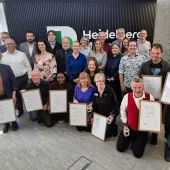Mannok relaunch Kestrel Cam

Company relaunches Ireland’s first kestrel webcam and participates in new colour-ringing project
MANNOK have relaunched Ireland’s first Kestrel Cam for the second consecutive year to help raise awareness and interest in the common kestrel, whose population is in decline on the island of Ireland where the species is now red listed, meaning it is at risk of extinction.
Through the Kestrel Cam – a live streaming webcam accessible via Mannok’s website – everyone can watch a breeding pair of kestrels which has returned to nest and raise young in the company’s quarry.
Also, for the second year, ecologist and licensed bird ringer Kez Armstrong visited the quarry to ring the chicks, and this time was able to use coloured rings thanks to a new project initiated by Irish Midlands Ringing Group, to significantly improve the visibility and research of kestrels.
To re-establish the Kestrel Cam for the second year, over the winter months when the birds had vacated the nest, Mannok’s environmental team collaborated with Netwatch to carefully install non-intrusive cameras licenced by the National Parks and Wildlife Service (NPWS).
Although this pair of kestrels has nested in the same nook of Mannok’s quarry face for the last five years, there was no certainty that they would choose the same nest again. Thankfully, however, the Kestrel Cam project was able to relaunch for a second year as the pair were spotted inspecting the same nest in February. The female laid her first egg on 6 April and 11 days later had five eggs in total, all of which hatched some four weeks later.
Commenting on the importance of Kestrel Cam, Mannok’s sustainability manager, Paul Monaghan, said: ‘Following the success of last year, we are delighted to launch Kestrel Cam once again. As a company with a significant area of landholdings, we have a duty to not only enhance and protect our local biodiversity while we operate, but to also raise awareness of the nature that surrounds us. Through this live feed capturing nature right on our doorstep, we want to help everyone to appreciate the nature that surrounds us.
‘Kestrel Cam is one of many projects we are working on for the benefit of the environment and we have plans to do much more, with many of our projects road mapped in our Mannok 230 Vision. This is our sustainability strategy which details our targets from now until the end of the decade, which are centred around three key pillars of People, Planet and Partners. Within our Planet pillar, we focus heavily on decarbonization, biodiversity, and resource efficiency, so our Kestrel Cam project is aligned to our environmental priorities.’
On 26 May, Kez Armstrong, who has been ringing birds for nearly 10 years and worked with more than 100 species, visited the Mannok quarry to ring the chicks. During her visit to the quarry, which remains fully operational with appropriate precautions in place so as not to disturb the birds and their habitat, Ms Armstrong commented on the importance of ringing chicks and revealed how excited she was to be colour ringing kestrel chicks.
‘The reason we ring birds is to capture information on bird’s behaviours, for example, to see how many birds are born in each nest, how far the birds are travelling, and where they are travelling. It is a nice, non-invasive method of tracking birds which doesn’t hurt or harm them. I’m really excited that we have colour rings on the chicks this year. It’s a new ringing project that is being run by the Irish Midlands Ringing Group. Soon we are going to be colour ringing kestrels across the island and am I very excited about the information we will find out as a result.’
Colour ringing involves fitting a unique colour-coded ring which is more visible and means birds can be identified and tracked more conveniently through photography and binoculars. The small metal ring which is usually used is often hard to read and only be visible when a bird is in very close in proximity, so the colour coded system will help improve scientific study of the birds’ movements.
During the ringing of the chicks, Ms Armstrong explained why kestrels are red listed in Ireland: ‘These are birds that don’t build their own nest; they seek out a natural cavity. Traditionally, they would have been nesting in old woodpecker holes in trees. Unfortunately, with agricultural intensification, we have lost a lot of our ancient forests which had natural cavities, so kestrels have had to seek out other nest sites. Quarries tend to have man-made cavities and they are now a preferred and important habitat for kestrels and many other birds. Mannok’s quarry has a perfect cavity for this pair, who have been coming back for at least five years, and hopefully they’ll return again and again.’
Over the next few weeks, the chicks will start to feed themselves, their adult feathers will begin to appear, and they will take their first flight. In late June and throughout July, the chicks will return to their nest sporadically. Wishing everyone an enjoyable few more weeks watching the live feed from the nest site, Ms Armstrong urged: ‘After the chicks fledge and move on as adult birds, get out and start reporting colour-ringed kestrels, as you are going to see a lot more of them over the next two to three years. With everyone’s help, we hope to build up a good picture of what our Irish kestrels are doing.’
To watch Mannok’s Kestrel Cam, click here.









